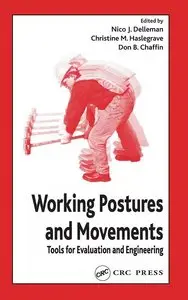Nico J. Delleman, Christine M. Haslegrave, Don B. Chaffin, "Working Postures and Movements: Tools for Evaluation and Engineering"
English | 2004 | ISBN: 0415279089 | PDF | 504 pages | 8,3 MB
English | 2004 | ISBN: 0415279089 | PDF | 504 pages | 8,3 MB
In most industries, musculoskeletal injuries are the most common work-related reason for employee absences. These injuries are often caused by static postures or repetitive movements that have to be maintained for many hours a day, such as intensive use of data entry devices, assembly work, parts inspection, equipment maintenance, manual materials handling, machinery operations, and vehicle operation, among others.
In order to prevent such injuries, occupational health professionals, ergonomists, production engineers, and product designers need to know how to evaluate postures and movements, and understand how these are determined by the work environment, as well as what design tools are available to achieve less stressful working postures and movements.
Working Postures and Movements describes many internationally accepted evaluation tools applicable to postures and movements in the work environment. Renowned researchers from around the world have brought together the latest scientific knowledge describing the anthropometry, biomechanics, physiology, psychophysics, and human perceptual-motor control basis for posture and movement assessment related to all the major body segments. The book addresses seating concepts, hand tool and pedal designs, foot-floor interfaces, digital human models for computer-aided design and engineering, and work organization (task duration, breaks, handling frequency) as they affect human performance and musculoskeletal injury reduction.
Professionals responsible for identifying and improving conditions in the industries where such workplace injuries occur will find this volume to be a handy sourcebook, while teachers and students will find it to be a valuable reference.



